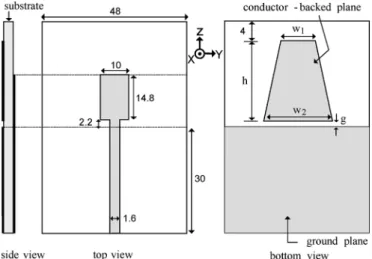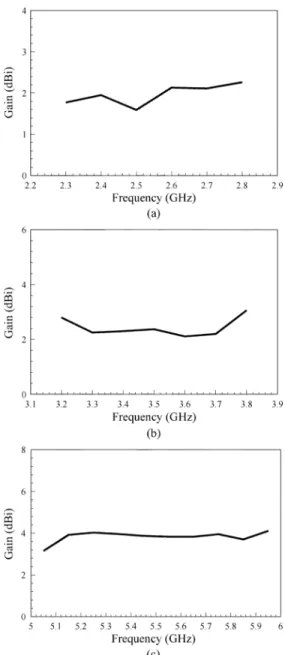IEEE ANTENNAS AND WIRELESS PROPAGATION LETTERS, VOL. 6, 2007 149
Dual Wideband Printed Monopole Antenna for
WLAN/WiMAX Applications
Chien-Yuan Pan, Tzyy-Sheng Horng, Senior Member, IEEE, Wen-Shan Chen, Senior Member, IEEE, and
Chien-Hsiang Huang
Abstract—A novel printed monopole antenna with dual
wide-bands is presented for simultaneously satisfying wireless local area network (WLAN) and worldwide interoperability for microwave access (WiMAX) applications. The antenna structure consists of a rectangular monopole with a microstrip feedline for excitation and a trapezoid conductor-backed plane for band broadening. The measured 10 dB bandwidth for return loss is from 2.01 to 4.27 GHz and 5.06 to 6.79 GHz, covering all the 2.4/5.2/5.8 GHz WLAN bands and 2.5/3.5/5.5 GHz WiMAX bands.
Index Terms—Dual-band antennas, monopole antennas, WiMAX antennas, WLAN antennas.
I. INTRODUCTION
T
HE multiband or broadband antennas have aroused high interest in recent years for application to multimode communication systems. Because of low cost and process sim-plicity, printed monopole antennas are very popular candidates for these applications. The currently popular designs suitable for wireless local area network (WLAN) operation in the 2.4 GHz (2.4–2.484 GHz) and 5.2/5.8 GHz (5.15–5.35 GHz/ 5.725–5.825 GHz) bands have been reported in [1]–[8]. The key design configurations in order to meet this dual-band operation include a monopole antenna fed with a meandered coplanar waveguide (CPW) [1], a CPW-fed monopole antenna with two resonant paths [2], a CPW-fed tapered bent folded monopole antenna [3], a microstrip-fed double-T monopole antenna [4], a meander-line monopole antenna with a backed microstrip line [5], a C-shaped monopole antenna with a shorted parasitic element [6], and a branched monopole antenna with a truncated ground plane [7]. However, to further support the worldwide interoperability for microwave access (WiMAX) applications, none of the above available designs can achieve a dual-band response with sufficiently large bandwidth to additionally cover the 2.5/3.5/5.5 GHz (2500–2690/3400–3690/5250–5850 MHz) WiMAX bands [9]. In [8], the authors presented a microstrip-fed crisscross monopole antenna with a square conductor-backed plane for dual-band WLAN applications. This design generally needs to consider many dimension parameters and the resultingManuscript received October 17, 2006; revised January 12, 2007. This work was supported in part by the Ministry of Education under Program of Aim for the Top University Plan, Taiwan, R.O.C., and by the National Science Council, Taiwan, R.O.C., by Grant 95-2221-E-110-027.
C.-Y. Pan, T.-S. Horng, and C.-H. Huang are with the Department of Elec-trical Engineering, National Sun Yat-Sen University, Kaohsiung 804, Taiwan, R.O.C. (e-mail: d8831816@student.nsysu.edu.tw).
W.-S. Chen is with the Department of Electronic Engineering, Southern Taiwan University of Technology, Tainan 710, Taiwan, R.O.C. (e-mail: chenws@mail.stut.edu.tw).
Digital Object Identifier 10.1109/LAWP.2007.891957
Fig. 1. Geometry of the proposed printed monopole antenna with dimensions in mm.
bandwidth is still not sufficient to cover the 3.5 GHz WiMAX bands. In this letter, a new antenna is proposed for the purpose of WLAN/WiMAX dual-mode operation. As illustrated in Fig. 1, the antenna is originally designed as a rectangular monopole fed by a 50- microstrip line. A metallic plate of trapezoid shape is placed under the rectangular monopole to perturb the resonant responses. This way, the antenna can achieve a dual wideband performance to simultaneously cover the most commonly used WLAN and WiMAX bands. This letter also provides detailed antenna dimensions and compar-isons between simulated and measured results.
II. ANTENNADESIGN ANDSIMULATION
Fig. 1 illustrates the geometry of the proposed dual wideband antenna for WLAN/WiMAX dual-mode operation. The antenna was implemented on an inexpensive FR4 substrate with thick-ness of 0.8 mm and relative permittivity of 4.4. It can be seen from Fig. 1 that the rectangular monopole and 50 microstrip feedline are printed on the top side of substrate, while a trape-zoid conducting plane and a semiground plane placed under the rectangular monopole and the microstrip feedline, respectively, are printed on the bottom side of substrate. The antenna per-formance is analyzed using high-frequency structure simulator (HFSS). In the proposed antenna configuration, the rectangular monopole can provide the fundamental and next higher resonant radiation band at 3.2 and 7.3 GHz, respectively, in the absence of the trapezoid conductor-backed plane. The trapezoid conductor backed plane can be regarded as a parasitic resonator electrically
PAN et al.: DUAL WIDEBAND PRINTED MONOPOLE ANTENNA 151
Fig. 5. Measured peak antenna gains against frequency for the proposed an-tenna in the (a) 2.3–2.8 GHz; (b) 3.2–3.8 GHz; and (c) 5.05–5.95 GHz bands.
of these radiation patterns, the antenna behaves quite similarly to the typical printed monopoles. The H-plane patterns are al-most omnidirectional in the lower band, alike to the ones at 2.5
and 3.5 GHz in Fig. 4(a) and (b), but appear more directional in the higher band, alike to the one at 5.5 GHz in Fig. 4(c). This is because the trapezoid conductor-backed plane radiates more electromagnetic waves at higher frequencies so as to deteriorate the radiation patterns more significantly. The measured peak antenna gains against frequency in the range of 2.3–2.8 GHz, 3.2–3.8 GHz, and 5.05–5.95 GHz are plotted in Fig. 5(a) to (c), respectively, all showing small variations of less than 1 dBi.
IV. CONCLUSION
A simple printed monopole antenna with a trapezoid con-ductor-backed plane for WLAN/WiMAX dual-mode operation has been presented. The use of trapezoid conductor-backed plane has increased impedance bandwidth very remarkably to sufficiently cover the 2.4/5.2/5.8 GHz WLAN bands and 2.5/3.5/5.5 GHz WiMAX bands. The final measured results show satisfactory performance and good agreement with the simulated results.
REFERENCES
[1] W. C. Liu and W. R. Chen, “CPW-fed compact meandered patch an-tenna for dual-band operation,” Electron. Lett., vol. 40, no. 18, pp. 1094–1095, Sep. 2004.
[2] T. H. Kim and D. C. Park, “CPW-fed compact monopole antenna for dual-band WLAN applications,” Electron. Lett., vol. 41, no. 6, pp. 292–293, Mar. 2005.
[3] Y.-D. Lin and P.-L. Chi, “Tapered bent folded monopole for dual-band wireless local area network (WLAN) systems,” IEEE Antenna Wireless
Propag. Lett., vol. 4, pp. 355–357, 2005.
[4] Y.-L. Kuo and K.-L. Wong, “Printed double-T monopole antenna for 2.4/5.2 GHz dual-band WLAN operations,” IEEE Trans. Antennas
Propag., vol. 51, no. 9, pp. 2187–2192, Sep. 2003.
[5] S. H. Choi, J. K. Park, S. K. Kim, and H. Y. S. Kim, “Design of dual-band antenna for the ISM dual-band using a backed microstrip line,” Microw.
Opt. Technol. Lett., vol. 41, no. 6, pp. 457–460, Jun. 2004.
[6] C.-Y. Huang and P.-Y. Chiu, “Dual-band monopole antenna with shorted parasitic element,” Electron. Lett., vol. 41, no. 21, pp. 1154–1155, Oct. 2005.
[7] M. N. Suma, R. K. Raj, M. Joseph, P. C. Bybi, and P. Mohanan, “A compact dual band planar branched monopole antenna for DCS/2.4 GHz WLAN applications,” IEEE Microw. Wireless Compon. Lett., vol. 16, no. 5, pp. 275–277, May 2006.
[8] C.-Y. Pan, C.-H Huang, and T.-S. Horng, “A novel printed monopole antenna with a square conductor-backed parasitic plane for dual-band WLAN applications,” in Proc. IEEE Antennas Propag. Soc. Int. Symp.
Dig., 2004, vol. 1, pp. 261–264.
[9] Deploying License-Exempt WiMAX Solutions Intel Corp. Santa Clara, CA, 2005 [Online]. Available: http://www.intel.com/netcomms/ technologies/wimax

